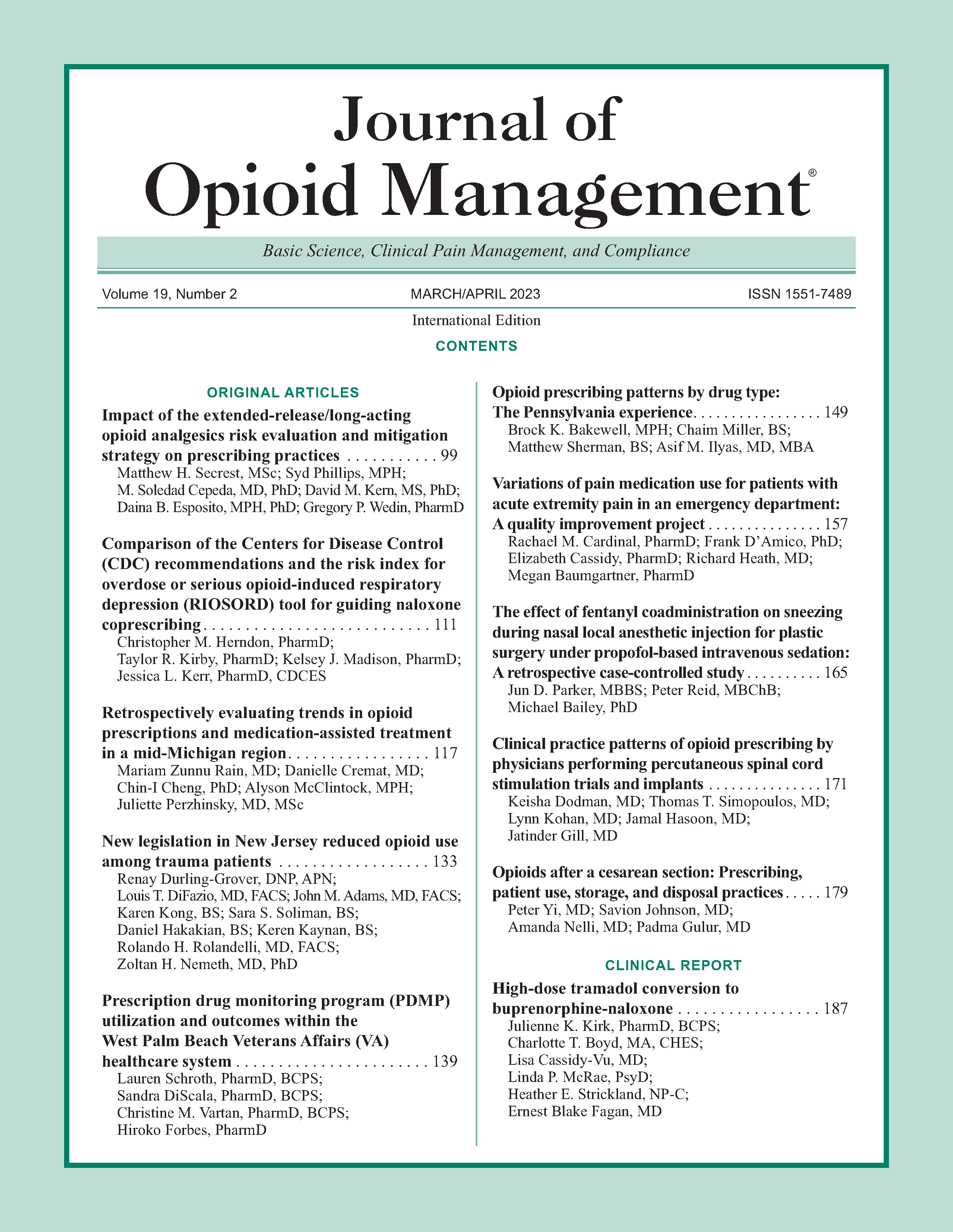New legislation in New Jersey reduced opioid use among trauma patients
DOI:
https://doi.org/10.5055/jom.2023.0767Keywords:
opioid, trauma, deaths, laws, prescribing, consumptionAbstract
Purpose: In New Jersey, politicians have emphasized the need to attenuate the ongoing opioid epidemic as opioid use disorder can lead to addiction and, in many cases, mortality. New legislation (New Jersey Senate Bill 3) was enacted in 2017 to reduce opioid prescription from 30 days to 5 days for acute pain in both inpatient and outpatient healthcare settings. Therefore, we sought to evaluate if the enactment of the bill influenced the consumption of opioid pain medication at an American College of Surgeons-verified Level I Trauma Center.
Methods: Patients from 2016 to 2018 were compared for differences in average daily inpatient morphine milligram equivalents (MMEs) consumption and injury severity score (ISS), among other parameters. To ensure that changes in pain medication did not affect the quality of pain management, we compared their average pain ratings.
Results: Although the average ISS in 2018 was higher than that in 2016 (10.6 ± 0.2 vs 9.1 ± 0.2, p < 0.001), opioid consumption decreased in 2018 without increasing the average pain rating for patients with an ISS of 9 and 10. More specifically, the average daily inpatient MMEs consumption dropped from 14.1 ± 0.5 in 2016 to 8.8 ± 0.3 in 2018 (p < 0.001). Even among patients with an average ISS >15, the total MMEs consumed per person decreased in 2018 (116.0 ± 14.0 vs 59.4 ± 7.6, p < 0.001).
Conclusion: Overall, opioid consumption was lower in 2018 without negatively affecting the quality of pain management. This suggests that the implementation of the new legislation has successfully reduced inpatient opioid use.
References
Seth P, Scholl L, Rudd RA, et al.: Overdose deaths involving opioids, cocaine, and psychostimulants—United States, 2015–2016. MMWR Morb Mortal Wkly Rep. 2018; 67: 349-358. DOI: 10.15585/mmwr.mm6712a1externalicon.
National Institute of Health on Drug Abuse: New Jersey: Opioid-involved deaths and related harms. 2019, March. Available at https://www.drugabuse.gov/drug-topics/opioids/opioid-summaries-by-state/new-jersey-opioid-involved-deathsrelated-harms. Accessed March 24, 2022.
Senate, No. 3 State of New Jersey 217th Legislature: 2017. Available at https://www.njleg.state.nj.us/2016/Bills/S0500/3_I1.HTM. Accessed March 24, 2022.
Brennan MJ: Update on prescription extended-release opioids and appropriate patient selection. J Multidiscip Healthc. 2013; 6: 265-280.
Chaudhary MA, Schoenfeld AJ, Harlow AF, et al.: Incidence and predictors of opioid prescription at discharge after traumatic injury. JAMA Surg. 2017; 152(10): 930-936.
Erekson DM, Bautista L, Albright D: Assessing risk of opioid misuse in the treatment of chronic pain: Building a practical actuarial approach. J Opioid Manag. 2018; 14(5): 381-391.
Romeiser JL, Labriola J, Meliker JR: Geographic patterns of prescription opioids and opioid overdose deaths in New York state, 2013-2015. Drug Alcohol Depend. 2019; 195: 94-100.
Available at https://doi.org/10.2016.j.drugaledep.2018.11.027. Accessed March 24, 2022.
Centers for Disease Control and Prevention: Provisional drug overdose death counts. Available at https://www.cdc.gov/nchs/nvss/vsrr/drug-overdose-data.htm. Accessed March 24, 2022.
Published
How to Cite
Issue
Section
License
Copyright 2005-2025, Weston Medical Publishing, LLC and Journal of Opioid Management. All Rights Reserved.











